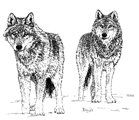Center, Internet, Wildlife Damage Management

Rocky Mountain Wolf Recovery: Annual Reports
Date of this Version
June 1999
Abstract
Gray wolf populations (Canis lupus) were extirpated from the western U.S. by the 1930s. Subsequently, wolves from Canada occasionally dispersed south into Montana and Idaho but failed to survive long enough to reproduce. Public attitudes toward predators changed and wolves received legal protection with the passage of the Endangered Species Act (ESA) in 1973. Wolves began to successfully recolonize northwestern Montana in the early 1980s. By 1995, 6 packs lived entirely in northwestern Montana. In 1995 and 1996, 66 wolves from southwestern Canada were reintroduced to Yellowstone National Park (YNP) (31 wolves) and central Idaho (35 wolves). The Rocky Mountain wolf population comprises 3 recovery areas: the Northwest Montana recovery area (NWMT, Figs.1, 2) which includes northwest Montana and the northern Idaho panhandle; the Greater Yellowstone recovery area (GYA, figs. 1,4) which includes Wyoming and adjacent parts of southeast Idaho and southeast Montana; and the Central Idaho recovery area (ID, Figs. 1, 3) which includes central Idaho and adjacent parts of southwest Montana. Wolves in the 3 recovery areas are managed under different guidelines, depending upon their designated status under the Endangered Species Act (ESA). NWMT wolves are classified as endangered, the most protected classification under the ESA. GYA and ID wolves are classified as nonessential experimental populations and managed with more flexible options than the endangered population.


Comments
ROCKY MOUNTAIN WOLF RECOVERY 1999 ANNUAL REPORT. Adapted from the online version at: http://www.fws.gov/mountain-prairie/species/mammals/wolf/annualrpt99/.